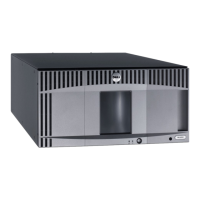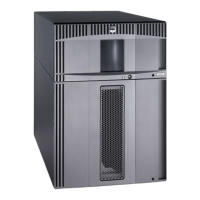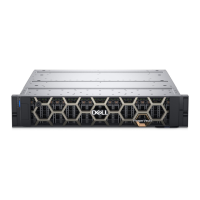Troubleshooting
file:///T|/htdocs/stor-sys/ML6000/en/html/ch09.htm[9/17/2012 1:50:53 PM]
You can restore the library's configurable items to a previous state using a saved configuration file. If you updated the library
firmware since last saving the configuration, the library automatically restores the library firmware to the version that was
saved with the configuration.
You can also downgrade library firmware to an earlier version using the Tools > Update Library Firmware
command. Note
that you will lose all your current library configuration information except for network settings, date and time, and license
keys. You can restore the other configurable items using a configuration file that was saved when the earlier version of library
firmware was installed on the library, or you can reconfigure your library's settings.
The Configuration operation is available only on the Web client. The path to open the appropriate screen is:
• From the Web client, select Tools > Save/Restore Configuration.
Troubleshooting "Library Not Ready" Messages
The operator panel and Web client each include a header that contains the company logo, product name, and the three main
navigation buttons Home, Help, and Logout. In addition, a message in the header alerts you when the library is not ready.
(No message displays in the header when the library is in a ready state.)
On the operator panel, LIBRARY NOT READY flashes at regular intervals whenever the library robotics are not yet ready to
perform library functions. To view more information about the library's condition, select Tools > About Library. The State
field on the About Library screen will display Not ready, followed, when applicable, by a brief explanation. For example, if
the library door is open, the State field will display: Not ready, door is open.
The header in the Web client also alerts you when the library is not ready. For instance, if the library door is open, the header
will display the following message: Library's door is open.
"Library Not Ready" messages appear in the header in the operator panel and the Web client under the following
circumstances:
• The robot is in the process of calibrating. When the robot has finished calibrating, the "Library Not Ready" message no
longer appears.
• The robot cannot calibrate. For example, a fiducial label is missing, preventing the robot from calibrating.
• The robot requires manual intervention. For example, the picker contains a tape cartridge that it cannot unload.
• The library door is open. The robot will not operate if the door is open.
• If none of the above situations apply, but the library is still not ready to operate, the header will display a "Library Not
Ready" message without additional detail. The library generates a RAS ticket whenever the library enters a "not ready"
state. The RAS ticket may provide information that can help you troubleshoot the problem. See
Viewing RAS Tickets
for more information.
"Library Not Ready" messages continue to display in the header as well as on the About Library screen until the issue has
been resolved, and the robot has completed its calibration.
Note: You may not see the "Library Not Ready" message in the Web client until the browser refreshes. Similarly, even
if the problem has been resolved, the "Library Not Ready" message will not disappear from the Web client until the
browser refreshes.
Duplicate Devices Discovered
If both target ports (ports 1 and 2) on an FC I/O blade are connected to the same host, or if more than one host is connected
to a target port, you may see duplicates of all the devices connected to the initiator ports (ports 3 – 6) of that FC I/O blade.
To prevent this from happening, you can do either (or both) of the following:
• If only one host is connected to a target port, you can use channel zoning to tell the target port which devices to see
(see
Configuring FC I/O Blade Channel Zoning).
• If more than one host is connected to a target port, you can use host mapping to tell each host which devices to see
(see Configuring Host Mapping).
Duplicate Medium Changers Discovered
You may see one or more medium changers being discovered multiple times. For information on why this happens, see FC I/O

